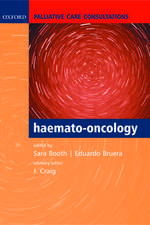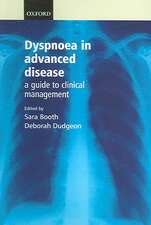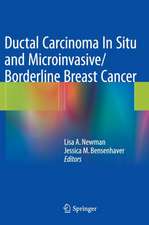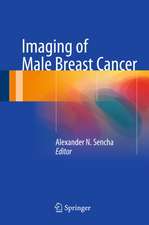Vascular Disruptive Agents for the Treatment of Cancer
Editat de Tim Meyeren Limba Engleză Paperback – 19 noi 2014
| Toate formatele și edițiile | Preț | Express |
|---|---|---|
| Paperback (1) | 1092.79 lei 6-8 săpt. | |
| Springer – 19 noi 2014 | 1092.79 lei 6-8 săpt. | |
| Hardback (1) | 1099.73 lei 6-8 săpt. | |
| Springer – 9 sep 2010 | 1099.73 lei 6-8 săpt. |
Preț: 1092.79 lei
Preț vechi: 1150.31 lei
-5% Nou
Puncte Express: 1639
Preț estimativ în valută:
209.11€ • 223.61$ • 174.35£
209.11€ • 223.61$ • 174.35£
Carte tipărită la comandă
Livrare economică 17 aprilie-01 mai
Preluare comenzi: 021 569.72.76
Specificații
ISBN-13: 9781489982261
ISBN-10: 1489982264
Pagini: 268
Ilustrații: IX, 256 p.
Dimensiuni: 155 x 235 x 14 mm
Greutate: 0.38 kg
Ediția:2010
Editura: Springer
Colecția Springer
Locul publicării:New York, NY, United States
ISBN-10: 1489982264
Pagini: 268
Ilustrații: IX, 256 p.
Dimensiuni: 155 x 235 x 14 mm
Greutate: 0.38 kg
Ediția:2010
Editura: Springer
Colecția Springer
Locul publicării:New York, NY, United States
Public țintă
ResearchDescriere
Angiogenesis (formation of new vessels from pre-existing ones) is a crucial early event in the process of tumor development. New vessels supply the tumor with nutrients that are needed for further local growth and enable distant metastases (Folkman 1995). Judah Folkman (1971) highlighted the potential therapeutic imp- cations of tumor angiogenesis. He hypothesized that if tumor angiogenesis is inhibited, then tumor growth and metastasis will be impaired greatly or even impossible. The subsequent quest for endogenous and exogenous inhibitors of angiogenesis has yielded a variety of promising therapeutic agents that block one or more angiogenic pathways, a few of which have been approved by the FDA (e. g. , bevacizumab, sorafenib, sunitinib) for use as single agents or in combination with chemotherapy in specific populations of cancer patients (Sessa et al. 2008). There has also been a dramatic expansion in the exploration of novel anti-angiogenic agents pre-clinically and in clinical trials (Ferrara 2002). Some of the most promising data comes from the development of agents that inhibit one of the key growth factors involved in tumor angiogenesis – vascular endothelial growth factor (VEGF) (Ferrara et al. 2003). Bevacizumab is a monoclonal antibody against VEGF that was the first an- angiogenic agent that improved significantly the overall survival of patients with colorectal and non-squamous non-small cell lung cancer (Ferrara et al. 2005). Various agents that target tumor angiogenesis are currently under investigation in different cancer types in many clinical trials (Ferrara and Kerbel 2005).
Cuprins
Introduction Graeme J. Dougherty and David J. ChaplinPre-clinical developmentThe discovery and characterisation of tumour endothelial markersDario Neri and Roy BicknellThe Use of Animal Models in the Assessment of Vascular Disrupting Agents R Barbara Pedley and Gillian M TozerCombination therapy with chemotherapy and Vascular Disrupting AgentsG. Taraboletti, K. Bonezzi and R. GiavazziLessons from Animal Imaging in Pre-Clinical ModelsLesley D. McPhail and Simon P. RobinsonCombining antiangiogenic drugs with vascular disrupting agents: Rationale and mechanisms of actionYuval Shaked, Paul Nathan, Laura G. Daenen, and Robert S. KerbelImaging in the development of vascular disruptive agents MRI to assess vascular disruptive agents Anwar Padhani and Martin ZweifelContrast ultrasound in imaging tumor angiogenesisGrzegorz Korpanty and Rolf A. Brekken Clinical development The Clinical Development of Tubulin Binding Vascular Disruptive AgentsMartin Zweifel and Gordon J.S.RustinASA404 (DMXAA): New Concepts in Tumour Vascular Targeting TherapyBruce C. BaguleyVascular disruptive agents in combination with radiotherapyHenry C. Mandeville and Peter J. Hoskin
Notă biografică
Dr. Tim Meyer is a Senior Lecturer in Medical Oncology at the UCL Cancer Institute in London where he specialises in gastrointestinal cancers and drug development. He trained in medicine at UCL and obtained his PhD from London University, after which he completed specialist training in medical oncology. His major research focus is antibody-based vascular targeting.
Textul de pe ultima copertă
Tumour survival and growth is critically dependent on an independent blood supply. As such tumour vasculature presents an ideal target for cancer therapy that is widely applicable, accessible and genetically stable rendering it less prone to resistance. Two approaches have been explored for cancer therapy; firstly the prevention of new vessel formation with inhibitors of angiogenesis, and secondly the destruction of existing tumour blood vessels with so called vascular disruptive agents (VDAs). While the first approach appears to delay tumour progression, the second has the potential to cause massive cell death and tumour regression. It is the second approach of vascular targeting that is the focus of this book. Since the tubulin binding agent combretastatin, derived from the bark of the African bush willow, was discovered by George R Pettit to have antimitotic properties over twenty years ago, the field of vascular targeting has expanded steadily. Coincident with the preclinical and clinical development of these agents, there have been advances in our understanding of their mechanism of action and in the technology required to assess their effects. This book aims to provide a comprehensive account of the current state of the art. Preclinical target identification and validation are discussed and the optimum pre-clinical animal models described. The imaging modalities that can be used to assess the efficacy of these agents are examined and a comprehensive review of the clinical development of key drugs is provided. Finally, the recent research exploring rational combinations of VDAs with other agents is reviewed and the potential place of VDAs in the future of cancer therapy is critically appraised.
Caracteristici
This book discusses preclinical target identification and validation, and the optimum pre-clinical animal models
Biomarkers and imaging modalities used to assess the efficacy of these agents are examined
A review of the clinical development of key drugs is provided
Recent research exploring rational combinations of VDAs with other agents is reviewed and the potential place of VDAs in the future of cancer therapy is critically appraised
Includes supplementary material: sn.pub/extras
Biomarkers and imaging modalities used to assess the efficacy of these agents are examined
A review of the clinical development of key drugs is provided
Recent research exploring rational combinations of VDAs with other agents is reviewed and the potential place of VDAs in the future of cancer therapy is critically appraised
Includes supplementary material: sn.pub/extras














